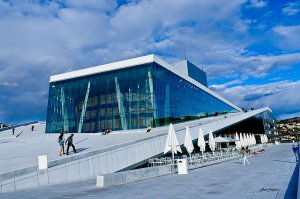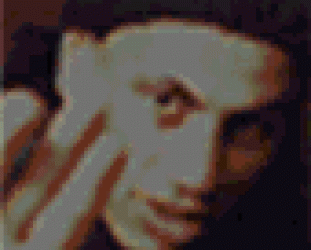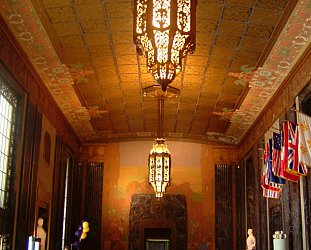Graham Reid | | 3 min read

Because architecture is the most public of all arts it has a powerful impact on the way we see and relate to our world: Architecture is the thoughtful making of spaces, we are told in this doco series, and we shape our buildings and our buildings shape us, to paraphrase Winston Churchill.
The premise of this series of 25 minute documentaries about six very different but important buildings (and not the most obvious, other than the Pompidou Centre) by various filmmakers – Wim Wenders, Michael Glawogger, Michael Madsen, Robert Redford, Margreth Olin and Karim Ainouz – is that if buildings could speak to us, what might they say about themselves. And us?
Unfortunately Wenders, turning his attention to the Berlin Philharmonic Hall which is first up here, goes the whole anthropomorphising route and so – in the whispery and pretentious voice of a woman who sounds like she has just been woken – the buildings speaks to us. Wenders manages to make it a dull conversationalist.
 Olin does something similar in her 25
minute study of the beautiful fjord-side Oslo Opera House by Tarald
Lundevall: “I am a house . . . [long pause for effect], they put
me here, in this neighbourhood of arrivals and departures, among the
brokenhearted and the brokenhearted . . .”
Olin does something similar in her 25
minute study of the beautiful fjord-side Oslo Opera House by Tarald
Lundevall: “I am a house . . . [long pause for effect], they put
me here, in this neighbourhood of arrivals and departures, among the
brokenhearted and the brokenhearted . . .”
The images focus on the performers and the enormous performance and rehearsal space available to them, but often this is at the expense of being shown the iceberg-like granite and marble building itself. Much of it is more like a narration-free feature about ballet dancers in rehearsal – the voice-over is also pretentiously poetic when it appears – and the building is rendered incidental.
Unless you like seeing ballet dancers (and God forbid, mimes) in rehearsal or loving close-ups this film is disappointing. You won't learn much about the Opera House, which looks superb in the few encompassing images shown.
Ainouz on the Pompidou Centre (designed by Richard Rogers and Renzo Piano) reverts to the building's voice too but is more plain spoken and keeps the focus on the cultural machine, his camera going into the bowels of the building to see a production in preparation (dancers again, directors love movement I guess). But again, for much of the duration we hear or see little of the construction of the building (until 10 minutes in) or of how the spaces work.
 Much better is Redford's beautifully
realised piece about the Salk Institute in Los Angeles which he lets
the architect Louis Khan (who enjoyed a close relationship with
scientist Jonas Salk who discovered the vaccine for polio), and the
scientists and workers who have inhabited the building speak in their
own, frequently poetic voices. And to these he couples design
drawings, black and white film and still from the period, and how
this marvelous building works today. It may look like a machine of
concrete but all attest to how well the building complex works in
practical manner, and how it is like a living organism in itself.
Much better is Redford's beautifully
realised piece about the Salk Institute in Los Angeles which he lets
the architect Louis Khan (who enjoyed a close relationship with
scientist Jonas Salk who discovered the vaccine for polio), and the
scientists and workers who have inhabited the building speak in their
own, frequently poetic voices. And to these he couples design
drawings, black and white film and still from the period, and how
this marvelous building works today. It may look like a machine of
concrete but all attest to how well the building complex works in
practical manner, and how it is like a living organism in itself.
Glawogger on the handsome 18th century National Library of Russia in St Petersburg dwells lovingly on the age and grace of the building. The library looks a beautifully chaotic mess, but one which works. As does the film.
 Perhaps most surprising is Halden
Prison in Norway (designed by Erik Moeller), a village in itself but
separated from the world by enormous walls, a massive gate and the
isolation they impose.
Perhaps most surprising is Halden
Prison in Norway (designed by Erik Moeller), a village in itself but
separated from the world by enormous walls, a massive gate and the
isolation they impose.
However Halden has been hailed as a model institution for its commitment to rehabilitation and despite its scale – it is breathtakingly huge and oppressively white inside its long corridors – the cells (rooms, more correctly) and grounds are impressively humane. Madsen also has the building speak for itself (a flat, female voice) but – perhaps because the subject is so different to the others here – this is quietly compelling, and you do get to understand the building, its design and pulse.
And its rules.
So while this collection is admirable in its intention, if it is architecture you have come here for you may well be disappointed. In many instances when these extraordinary buildings speak for themselves they deliver little more than poetic platitudes and the images accompanying them may be beautifully shot, but frequently convey less information than the filmmaker might think.
For more on architects and architecture at Elsewhere start here.





post a comment